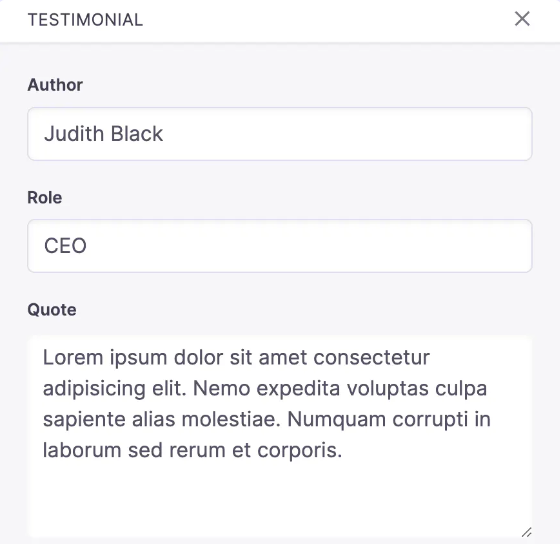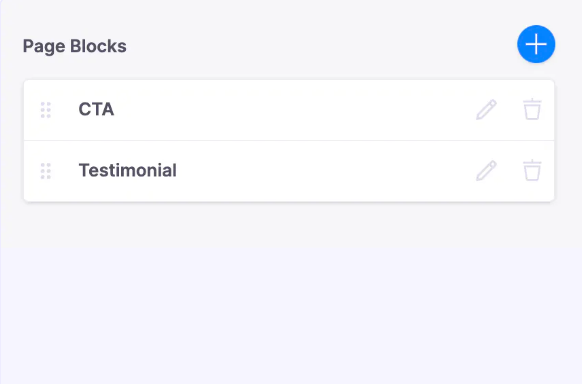The "object" field
object Type
The object field is a dynamic field type that creates a nested page in the CMS with the data it contains.
This can be used to create repeated data structures, group related data in the CMS and/or give users the option to choose between a set of templates.
type ObjectField = {label: stringname: stringtype: 'object'list?: boolean// `fields` OR `templates` may be provided, not bothfields?: Field[]templates?: Template[]/** Customize the default "_template" key that gets setin a document to identify a block-type.Only applicable when list: true **/templatesKey?: string// See https://tina.io/docs/extending-tina/overview/ for customizing the UIui?: {// Whether or not the Visual Selector is enabled. See https://tina.io/docs/editing/blocks/#adding-a-visual-block-selector-experimentalvisualSelector?: boolean,// defaultItem can only can be used when {list: true}defaultItem?: Record<string, any> | () => Record<string, any>,itemProps?(item: Record<string, any>): {label?: string}}}
Usage
Ultimately there are 3 ways to configure this type...
- With
listset tofalse, thefieldsarray can be used to wrap some data – this appears in the editor as a nested page. This can be used to organise the CMS, such as grouping options together, as in the gif below. - With
listset totrue, thefieldsarray contains the data structure to be repeated – this appears in the editor as above, but grouped as a list. - With
listset totrue, and usingtemplatesas opposed tofieldsthe user can select between associated templates – this appears as above, but pressing the+gives you the option to choose between templates.
Scenario: We have a component on our site that needs to hold an array of other field types, so we define it as a type object. Some of the field types within this parent object are also objects themselves.
import type { Template, TinaField } from 'tinacms';export const featuresTemplate: Template = {label: 'Feature Block',name: 'featureBlock',fields: [{name: 'featureItem',label: 'Feature Items',type: 'object',list: true,ui {itemProps: (item) => {return { label: item?.headline };},},fields: [{ name: 'headline', label: 'Headline', type: 'string' },{name: 'description', label: 'Description',type: 'string', ui: { component: 'textarea' }},{name: 'buttons',label: 'Buttons',list: true,type: 'object',ui: {visualSelector: true,itemProps: (item) => {return { label: item?.label };},},templates: [actionsButtonTemplate as Template,codeButtonTemplate as Template,modalButtonTemplate as Template],},] as TinaField[],},],};
Code-Block Breakdown
- We originally have a list of feature item objects, each of these objects store an array [Headline, description, buttons]
- Each feature item in the list has a dynamic label so that we can differentiate between each feature item in our editor (lines 12-14)
- We then have some reusable objects which are stored as a list within our buttons element of the featureBlock array
- Because each of our unique 3 button templates also stores an array of variables themself, we use the type: object
An example of what this object array would look like is
{'headline': 'Feature Item 1','description': 'All stuff Tina!','buttons': [{label: 'Button A',href: '/docs',},{label: 'Button B',href: '/blog'}],},{'headline': 'Feature Item 2','description': 'This feature has no buttons'}
More Examples
Tina will generate the appropriate component depending on the configuration provided.
A basic object configuration
{label: "Testimonial",name: "testimonial",type: "object",fields: [{label: "Author",name: "author",type: "string"},{label: "Role",name: "role",type: "string"},{label: "Quote",name: "quote",type: "string",ui: {component: "textarea"}}]}
As a list with default values
{label: "Testimonials",name: "testimonials",type: "object",list: true,ui: {itemProps: (item) => {return { label: `${item?.author} ( ${item?.role} ) ` }},defaultItem: {author: "Judith Black",role: "CEO",quote: "Lorem ipsum dol..."}},fields: [{name: "author",// ...},{name: "role",// ...},{name: "quote",// ...}]}

Using list object as a wrapper for other types
Number, boolean, datetime, reference and rich-text field types can be used as the sole field of an object to create a list of one of those types.
{label: "Author List",name: "authorList",type: "object",list: true,fields: [{label: 'Author',name: 'author',type: 'reference',collections: ['author'],},]}
Using templates instead of fields
{label: "Page Blocks",name: "pageBlocks",type: "object",list: true,templates: [{label: "CTA",name: "cta",fields: [...]},{label: "Testimonial",name: "testimonial",fields: [...]}]}

Last Edited: November 26, 2024
© TinaCMS 2019–2024